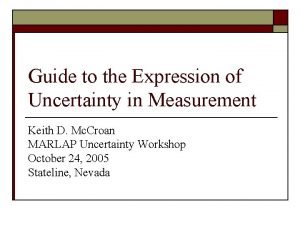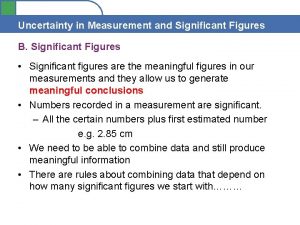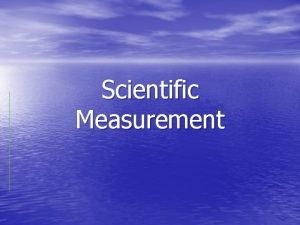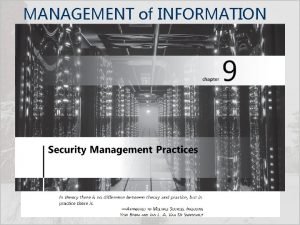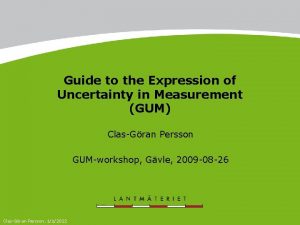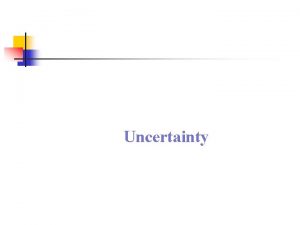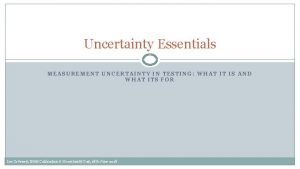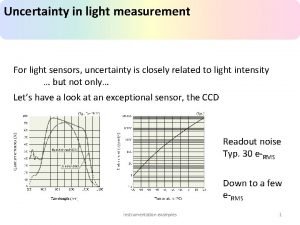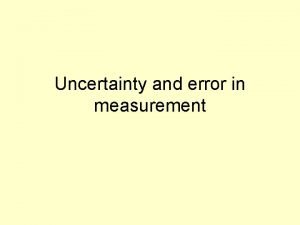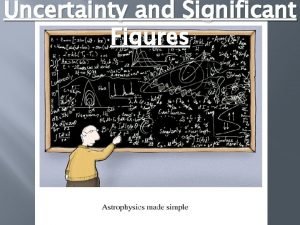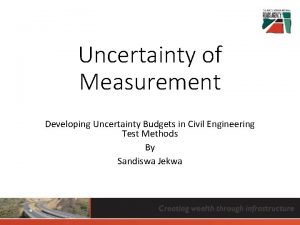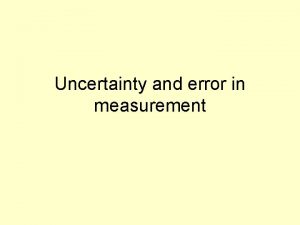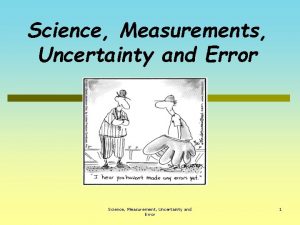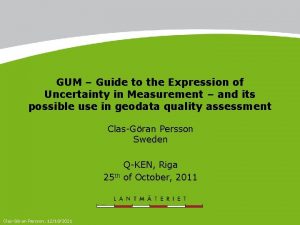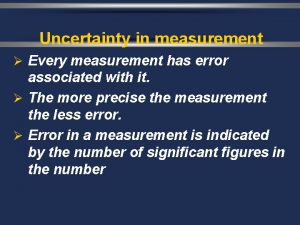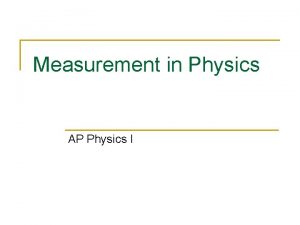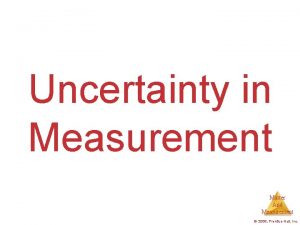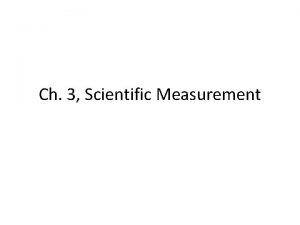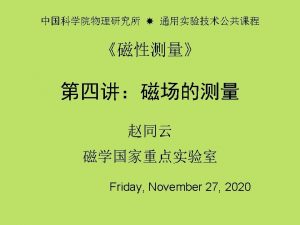Guide to the Expression of Uncertainty in Measurement








































- Slides: 40

Guide to the Expression of Uncertainty in Measurement Keith D. Mc. Croan MARLAP Uncertainty Workshop October 24, 2005 Stateline, Nevada

Introduction o o o Guide to the Expression of Uncertainty in Measurement was published by the International Organization for Standardization in 1993 in the name of 7 international organizations Corrected and reprinted in 1995 Usually referred to simply as the “GUM”

The Seven Sponsors o o o o International Bureau of Weights and Measures (BIPM) International Electrotechnical Commission (IEC) International Federation of Clinical Chemistry (IFCC) International Organization for Standardization (ISO) International Union of Pure and Applied Chemistry (IUPAC) International Union of Pure and Applied Physics (IUPAP) International Organization of Legal Metrology (OIML)

Stated Purposes o o Promote full information on how uncertainty statements are arrived at Provide a basis for the international comparison of measurement results

Benefits o o Much flexibility in the guidance Provides a conceptual framework for evaluating and expressing uncertainty Promotes the use of standard terminology and notation All of us can speak and write the same language when we discuss uncertainty

What Is Measurement Uncertainty? o o “parameter, associated with the result of a measurement, that characterizes the dispersion of the values that could reasonably be attributed to the measurand” – GUM, VIM Examples: n n A standard deviation (1 sigma) or a multiple of it (e. g. , 2 or 3 sigma) The half-width of an interval having a stated level of confidence

The Measurand o In any measurement, the measurand is defined as the “particular quantity subject to measurement” o For example, if you’re trying to determine the massic activity of 239 Pu in a specified sample of soil as of a specified date and time, that is the measurand

Error of Measurement o o In metrology the error of a measurement is the difference between the result and the actual value of the measurand The error is treated as a random variable n n With mean and standard deviation True even for systematic error (discussed later)

Error vs. Uncertainty o o o In metrology, error is primarily a theoretical concept, because its value is unknowable Uncertainty is a more practical concept Evaluating uncertainty allows you to place a bound on the likely size of the error It is a critical aspect of metrology A measured value without some indication of its uncertainty is useless

Random & Systematic Errors o o o Error can be decomposed into random and systematic parts The random error varies when a measurement is repeated under the same conditions (e. g. , radiation counting) The systematic error remains fixed when the measurement is repeated under the same conditions (e. g, error in a γ-ray emission probability)

Correcting for Systematic Error o o o If you know that a substantial systematic error exists and you can estimate its value, include a correction (additive) or correction factor (multiplicative) in the model to account for it Remember: the correction term or factor itself has uncertainty A small residual systematic error generally remains after all known corrections have been applied

Uncertainty of measurement accounts for random error and systematic error o Does not account for blunders or other spurious errors, such as those caused by equipment failure Spurious errors represent loss of statistical control of the measurement process o

The Measurement Model o o o Usually the final result of a measurement is not measured directly, but is calculated from other measured quantities through a functional relationship We’ll call this function a “measurement model” The model might involve several equations, but we’ll follow the GUM and represent it abstractly as a single equation:

Example: Radiochemistry In radiochemistry, a simple model might look like where a denotes massic activity (the measurand), Cs the sample count, ts the sample count time, ε the detection efficiency, etc.

Input and Output Quantities o o In the generic model Y = f(X 1, …, XN), the measurand is denoted by Y Also called the output quantity The quantities X 1, …, XN are called input quantities The value of the output quantity (measurand) is calculated from the values of the input quantities using the measurement model

Input and Output Estimates o o When one performs a measurement, one obtains estimated values x 1, x 2, …, x. N for the input quantities X 1, X 2, …, XN These estimated values may be called input estimates One plugs input estimates into the model and calculates an estimated value for the output quantity The calculated estimate may be called an output estimate

Propagation of Uncertainty o o When a measurement model is used to estimate the value of the measurand, the uncertainty of the output estimate is usually obtained by mathematically combining the uncertainties of the input estimates The mathematical operation of combining the uncertainties is called propagation of uncertainty

Standard Uncertainty o o Before propagating uncertainties of input estimates, you must express them in comparable forms The commonly used approach is to express each uncertainty in the form of an estimated standard deviation, called a standard uncertainty The standard uncertainty of an input estimate xi is denoted by u(xi) Radiochemists traditionally called this “one sigma” uncertainty

Combined Standard Uncertainty o The standard uncertainty of an output estimate obtained by uncertainty propagation is called the combined standard uncertainty o The combined standard uncertainty of the output estimate y is denoted by uc(y)

Methods for Uncertainty Evaluation o o The GUM classifies methods of uncertainty evaluation (for input estimates) as either Type A or Type B Type A: method of evaluation by statistical analysis of series of observations Type B: method of evaluation by any means other than statistical analysis of series of observations If it isn’t Type A, it’s Type B

Combining Uncertainties o o All uncertainty components are treated alike for the purpose of uncertainty propagation One does not distinguish between Type A uncertainties and Type B uncertainties when propagating them to obtain the combined standard uncertainty

Random & Systematic o o Twenty years ago, it was common to call a Type A uncertainty a “random uncertainty” and a Type B uncertainty a “systematic uncertainty” The GUM explicitly disparages those terms now So avoid them But recall that the terms “random error” and “systematic error” are still accepted (when referring to error, not uncertainty)

Examples: Type A o o Make a series of observations of an input quantity Xi Let xi be the arithmetic mean and let u(xi) be the experimental standard deviation of the mean (the “standard error” of the mean) Least-squares regression can also be a Type A method If there is a well-defined number of “degrees of freedom” (number of observations minus number of parameters estimated), it’s probably a Type A method of evaluation

Examples: Type B o o o Often a Type B evaluation involves estimating a bound, a, for the largest possible error in the estimate, xi, and dividing by an appropriate constant based on an assumed distribution for the error For example, if you believe the true value lies within ±a of the estimated value, xi, but you know nothing more than that, assume a rectangular distribution, and divide a by to obtain u(xi) Example: Uncertainty associated with rounding on a digital display

Rectangular Distribution xi − a xi xi + a

Triangular Distribution o o Sometimes you can estimate a bound, a, for the error, but you believe that values near xi are more likely than those farther away In this case, you might assume a triangular distribution for the error If so, you divide a by to obtain u(xi) Example: Capacity of a pipette, with a specified nominal volume and tolerance

Triangular Distribution xi − a xi xi + a

Imported Values o o o There are many other possible Type B methods E. g. , using the value and standard uncertainty of the half-life of a radionuclide published by NNDC A calibration certificate for a standard might provide a confidence interval for the value with some specified level of confidence, such as 95 % n Assume a normal distribution and derive standard uncertainty from percentiles of that distribution (e. g. , if the confidence level is 95 %, divide the half-width of the confidence interval by 1. 96)

What about Counting Uncertainty? o o Make a radiation counting measurement, where C counts are observed Let xi = C and u(xi) = What type of uncertainty evaluation is this: Type A or Type B? This method of evaluation presumes Poisson counting statistics n n Beware – Sometimes the distribution isn’t Poisson Note – Counting uncertainty isn’t the total uncertainty

Correlations o o o An issue sometimes neglected in uncertainty evaluation is the fact that some input estimates may be correlated with each other May either increase or decrease the uncertainty of the final result One common example is the correlation that often exists between the parameters for a calibration curve fit by least squares

Notation for Correlations o o If you know there is a correlation between two input estimates xi and xj, you should evaluate it and propagate it Estimated correlation coefficient (a number between − 1 and +1) is denoted by r(xi, xj) The estimated covariance of xi and xj is denoted by u(xi, xj) = r(xi, xj) × u(xi) × u(xj)

Uncertainty Propagation Formula o o Most commonly used equations for uncertainty propagation are based on the general equation shown below, which the GUM calls the “law of propagation of uncertainty” MARLAP prefers “uncertainty propagation formula”

Sensitivity Coefficients o o o The partial derivatives ∂f/∂xi that appear in the uncertainty propagation formula are called sensitivity coefficients These derivatives are evaluated at the measured values of the input estimates OK to approximate them – You don’t necessarily have to calculate them using formulas from calculus

Components of Uncertainty o The term component of uncertainty means several things, but one definition is explicit in the GUM o The component of the combined standard uncertainty, uc(y), generated by the standard uncertainty u(xi) is the product of the absolute value of the sensitivity coefficient ∂f/∂xi and u(xi), which may be denoted by ui(y)

Uncertainty Propagation o o Uncertainty propagation formula is derived from a first-order Taylor-polynomial approximation of f It is commonly used, but the approximation is not great in some situations (e. g. , dividing one value by another value with a very large relative uncertainty)

Automatic Uncertainty Propagation o o Many find the uncertainty propagation formula intimidating, but it is actually straightforward Simple enough to be done automatically in most cases by software libraries In the presenter’s opinion, uncertainty propagation is one of the easiest aspects of uncertainty evaluation The hard part is understanding the measurement process well enough to recognize and evaluate uncertainties that ought to be propagated

Expanded Uncertainty o o It is common to multiply the combined standard uncertainty, uc(y), by a factor, k, chosen so that the interval y ± kuc(y) has a specified high probability of containing the true value of the measurand GUM calls product U = k×uc(y) an expanded uncertainty Factor k is called a coverage factor (often k=2 or 3) The probability that y ± U contains the true value is called the coverage probability, p

Summary of Steps o o Define the measurand construct the mathematical model of the measurement Obtain estimates, xi, of the input quantities Evaluate the standard uncertainties u(xi), by Type A or Type B methods, and evaluate the covariance u(xi, xj) for each pair of correlated input estimates xi and xj Apply the model to evaluate the output estimate, y

Summary of Steps…Continued o o Propagate the standard uncertainties u(xi) and covariances u(xi, xj) to obtain the combined standard uncertainty uc(y) Optionally, multiply uc(y) by a coverage factor, k, to obtain an expanded uncertainty, U Report the result, y, with either the combined standard uncertainty, uc(y), or the expanded uncertainty, U Explain the uncertainty clearly

Questions?
 Guide to the expression of uncertainty in measurement
Guide to the expression of uncertainty in measurement Significant figures cartoon
Significant figures cartoon Measurements and their uncertainty
Measurements and their uncertainty Linear term
Linear term Security performance management
Security performance management Hình ảnh bộ gõ cơ thể búng tay
Hình ảnh bộ gõ cơ thể búng tay Lp html
Lp html Bổ thể
Bổ thể Tỉ lệ cơ thể trẻ em
Tỉ lệ cơ thể trẻ em Gấu đi như thế nào
Gấu đi như thế nào Thang điểm glasgow
Thang điểm glasgow Hát lên người ơi alleluia
Hát lên người ơi alleluia Môn thể thao bắt đầu bằng từ chạy
Môn thể thao bắt đầu bằng từ chạy Thế nào là hệ số cao nhất
Thế nào là hệ số cao nhất Các châu lục và đại dương trên thế giới
Các châu lục và đại dương trên thế giới Công thức tiính động năng
Công thức tiính động năng Trời xanh đây là của chúng ta thể thơ
Trời xanh đây là của chúng ta thể thơ Mật thư anh em như thể tay chân
Mật thư anh em như thể tay chân Làm thế nào để 102-1=99
Làm thế nào để 102-1=99 độ dài liên kết
độ dài liên kết Các châu lục và đại dương trên thế giới
Các châu lục và đại dương trên thế giới Thơ thất ngôn tứ tuyệt đường luật
Thơ thất ngôn tứ tuyệt đường luật Quá trình desamine hóa có thể tạo ra
Quá trình desamine hóa có thể tạo ra Một số thể thơ truyền thống
Một số thể thơ truyền thống Cái miệng bé xinh thế chỉ nói điều hay thôi
Cái miệng bé xinh thế chỉ nói điều hay thôi Vẽ hình chiếu vuông góc của vật thể sau
Vẽ hình chiếu vuông góc của vật thể sau Thế nào là sự mỏi cơ
Thế nào là sự mỏi cơ đặc điểm cơ thể của người tối cổ
đặc điểm cơ thể của người tối cổ Ví dụ giọng cùng tên
Ví dụ giọng cùng tên Vẽ hình chiếu đứng bằng cạnh của vật thể
Vẽ hình chiếu đứng bằng cạnh của vật thể Vẽ hình chiếu vuông góc của vật thể sau
Vẽ hình chiếu vuông góc của vật thể sau Thẻ vin
Thẻ vin đại từ thay thế
đại từ thay thế điện thế nghỉ
điện thế nghỉ Tư thế ngồi viết
Tư thế ngồi viết Diễn thế sinh thái là
Diễn thế sinh thái là Các loại đột biến cấu trúc nhiễm sắc thể
Các loại đột biến cấu trúc nhiễm sắc thể So nguyen to
So nguyen to Tư thế ngồi viết
Tư thế ngồi viết Lời thề hippocrates
Lời thề hippocrates Thiếu nhi thế giới liên hoan
Thiếu nhi thế giới liên hoan
